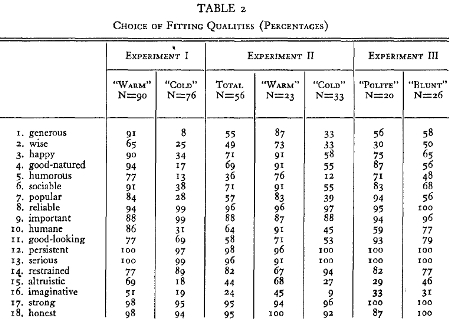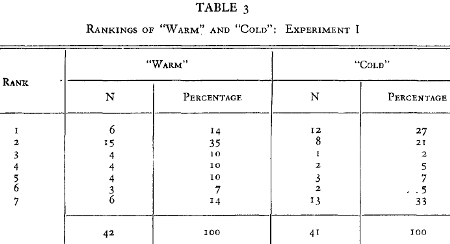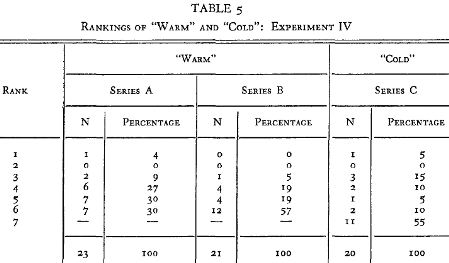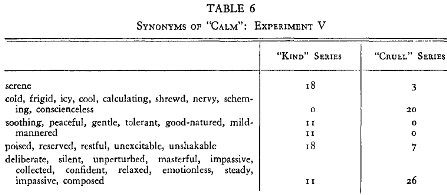A. Variation of a Central Quality
Observation suggests that not all qualities have the same weight in establishing the view of a person. Some are felt to be basic, others secondary. In the following experiments we sought for a demonstration of this process in the course of the formation of an impression.
Experiment 1.
Two groups, A and B, heard read a list of character-qualities, identical save for one term. The list follows:
A. intelligent—skillful—industrious—warm—determined—practical—cautious
B. intelligent—skillful—industrious—cold—determined—practical—cautious
Group A heard the person described as "warm"; Group B, as "cold."
Technique
The instructions were as described above. Following the reading, each subject wrote a brief sketch. The sketches furnish concrete evidence of the impressions formed. Their exact analysis involves, however, serious technical difficulties. It seemed, therefore, desirable to add a somewhat simpler procedure for the determination of the content of the impression and for the purpose of group comparisons. To this end we constructed a check list sense of what was fitting or relevant. Some of the terms were taken from written sketches of subjects in preliminary experiments. In the examination of results we shall rely upon the written sketches for evidence of the actual character of the impressions, and we shall supplement these with the quantitative results from the check list.
There were 90 subjects in Group A (comprising four separate classroom groups), 76 subjects in Group. B (comprising four separate classroom groups).
Results
Are the impressions of Groups A and B identical, with the exception that one has the added quality of "warm," the other of "cold"? This is one possible outcome. Another possibility is that the differentiating quality imparts a general plus or minus direction to the resulting impression.
We shall see that neither of these formulations accurately describes the results. We note first that the characteristic "warm-cold" produces striking and consistent differences of impression. In general, the A-impressions are far more positive than the B-impressions. We cite a. few representative examples:
Series A ("warm")
A person who believes certain things to be right, wants others to see his point, would be sincere in an argument' and would like to see his point won.
A scientist performing experiments and persevering after many setbacks. He is driven by the desire to accomplish something that would be of benefit.
Series B ("cold")
A very ambitious and talented person who would not let anyone or anything stand in the way of achieving his goal. Wants his own way, he is determined not to give in, no matter what happens.
A rather snobbish person who feels that his success and intelligence set him apart from the run-of-the-mill individual. Calculating and unsympathetic.
This trend is fully confirmed in the check-list choices. In Table 2 we report the frequency (in terms of percentages) with which each term in the check list was selected. For the sake of brevity of presentation we state the results for the positive term in each pair; the reader may determine the percentage of choices for the other term in each pair by subtracting the given figure from 100. To illustrate, under Condition A of the present experiment, 91 per cent of the subjects chose the designation "generous"; the remaining 9 per cent selected the designation "ungenerous." Occasionally, a subject would not state a choice for a particular pair. Therefore, the number of cases on which the figures are based is not always identical; however, the fluctuations were minor, with the exception of the category "good-looking— unattractive," which a larger proportion of subjects failed to answer.
We find:
1. There are extreme reversals between Groups A and B in the choice of fitting characteristics. Certain qualities are preponderantly assigned to the "warm" person, while the opposing qualities are equally prominent in the "cold" person. This holds for the qualities of (1) generosity, (2) shrewdness, (3) happiness, (4) irritability, (5) humor, (6) sociability, (7) popularity, (10) ruthlessness, (15) self-centeredness, (16) imaginativeness.
2. There is another group of qualities which is not affected by the transition from "warm" to "cold," or only slightly affected. These are: (8) reliability, (9) importance, (u) physical attractiveness, (12) persistence, (13) seriousness, (14) restraint, (17) strength, (18) honesty.
These results show that a change in one character-quality has produced a widespread change in the entire impression. Further, the written sketches show that the terms "warm-cold" did not simply add a new quality, but to some extent transformed the other characteristics. With this point we shall deal more explicitly in the experiments to follow.
That such transformations take place is also a matter of everyday experience. If a man is intelligent, this has an effect on the way in which we perceive his playfulness, happiness, friendliness. At the same time, this extensive change does not function indiscriminately. The "warm" person is not seen more favorably in all respects. There is a range of qualities, among them a number that are basic, which are not touched by the distinction between "warm" and "cold." Both remain equally honest, strong, serious, reliable, etc.
The latter result is of interest with reference to one possible interpretation of the findings. It might be supposed that the category "warm-cold" aroused a "mental set" or established a halo tending toward a consistently plus or minus evaluation. We observe here that this trend did not work in an indiscriminate manner, but was decisively limited at certain points. If we assume that the process of mutual influence took place in terms of the actual character of the qualities in question, it is not surprising that some will, by virtue of their content, remain unchanged.
The following will show that the subjects generally felt the qualities "warm-cold" to be of primary importance. We asked the subjects in certain of the groups to rank the terms of Lists A and B in order of their importance for determining their impression. Table 3, containing the distribution of rankings of "warm-cold," shows that these qualities ranked comparatively high. At the same time a considerable number of subjects relegated "cold" to the lowest position. That the rankings are not higher is due to the fact that the lists contained other central traits.
These data, as well as the ranking of the other traits not here reproduced, point to the following conclusions:
1. The given characteristics do not all have the same weight for the subject. He assigns to some a higher importance than to others.
2. The weight of a given characteristic varies—within limits*—from subject to subject.
Certain limitations of the check-list procedure need to be considered: (1) The subject's reactions are forced into an appearance of discreteness which they do not actually possess, as the written sketches show; (2) the check list requires the subject to choose between extreme characteristics, which he might prefer to avoid; (3) the quantitative data describe group trends; they do not represent adequately the form of the individual impression. Generally the individual responses exhibit much stronger trends in a consistently positive or negative direction. For these reasons we employ the check-list results primarily for the purpose of comparing group trends under different conditions. For this purpose the procedure is quite adequate.
B. Omission of a Central Quality
That the category "warm-cold" is significant for the total impression may be demonstrated also by omitting it from the series. This we do in the following experiment.
Experiment II
The procedure was identical with that of Experiment I, except that the terms "warm" and "cold" were omitted from the list read to the subject (intelligent - skillful - industrious - determined – practical - cautious). Also the check list was identical with that of Experiment I, save that "warm-cold" was added as the last pair. There were three groups, consisting of a total of 56 subjects.
Under these conditions the selection of fitting characteristics shows a significant change. The distribution of choices for the total group (see Table 2, column labeled "Total") now falls between the "warm" and "cold" variations of Experiment I. It appears that a more neutral impression has formed. The total group results are, however, largely a statistical artifact. An examination of the check-list choices of the subjects quickly revealed strong and consistent individual differences. They tended to be consistently positive or negative in their evaluations. It will be recalled that the terms "warm-cold" were added to the check list. This permitted us to subdivide the total group according to whether they judged the described person on the check list as "warm" or "cold." Of the entire group, 23 subjects (or 41 per cent) fell into the "warm" category. Our next step was to study the distribution of choices in the two subgroups. The results are clear: the two subgroups diverge consistently in the direction of the "warm" and the "cold" groups, respectively, of Experiment I. (See Table 2.) This is especially the case with the two "warm" series, which are virtually identical.
It is of interest that the omission of a term from the experimental list did not function entirely as an omission. Instead, the subjects inferred the corresponding quality in either the positive or negative direction. While not entirely conclusive, the results suggest that a full impression of a person cannot remain indifferent to a category as fundamental as the one in question, and that a trend is set up to include it in the impression on the basis of the given data. In later experiments too we have found a strong trend to reach out toward evaluations which were not contained in the original description.
C. Variation of a Peripheral Quality
Would a change of any character quality produce an effect as strong as that observed above? "Warm" and "cold" seem to be of special importance for our conception of a person. This was, in fact, the reason for selecting them for study. If there are central qualities, upon which the content of other qualities depends, and dependent qualities which are secondarily determined, it should be possible to distinguish them objectively. On this assumption the addition or omission of peripheral qualities should have smaller effects than those observed in Experiment I. We turn to this question in the following experiment.
Experiment III
The following lists were read, each to a different group:
A. intelligent—skillful—industrious—polite—determined—practical cautious
B. intelligent—skillful—industrious—blunt—determined—practical—cautious
The A group contained 19, the B group 26 subjects.
The changes introduced into the selection of fitting characteristics in the transition from "polite" to "blunt" were far weaker than those found in Experiment I (see Table 2). There is further evidence that the subjects themselves regarded these characteristics as relatively peripheral, especially the characteristic "polite." If we may take the rankings as an index, then we may conclude that a change in a peripheral trait produces a weaker effect on the total impression than does a change in a central trait. (Though the changes produced are weaker than those of Experiment I, they are nevertheless substantial. Possibly this is a consequence of the thinness of the impression, which responds easily to slight changes.)
D. Transformation from a Central to a Peripheral Quality
The preceding experiments have demonstrated a process of discrimination between central and peripheral qualities. We ask: Are certain qualities constantly central? Or is their functional value, too, dependent on the other characteristics?
Experiment IV
We selected for observation the quality "warm," which was demonstrated to exert a powerful effect on the total impression (Experiments I and II). The effect of the term was studied in the following two series:
A. obedient—weak—shallow—warm—unambitious— vain
B. vain — shrewd — unscrupulous — warm — shallow—envious
Immediately "warm" drops as a significant characteristic in relation to the others, as the distribution of rankings appearing in Table 5 shows.
(Compare Table 3 of Experiment I.)
More enlightening are the subjects' comments. In Series A the quality "warm" is now seen as wholly dependent, dominated by others far more decisive.
I think the warmth within this person is a warmth emanating from a follower to a leader.
The term "warm" strikes one as being a dog-like affection rather than a bright friendliness. It is passive and without strength.
His submissiveness may lead people to think he is kind and warm.
A more extreme transformation is observed in Series B. In most instances the warmth of this person is felt to lack sincerity, as appears in the following protocols:
I assumed the person to appear warm rather than really to be warm.
He was warm only when it worked in with his scheme to get others over to his side. His warmth is not sincere.
A similar change was also observed in the content of "cold" in a further variation. The subject heard List B of Experiment I followed by Series C below, the task being to state whether the term "cold" had the same meaning in both lists.
C. intelligent—skillful—sincere—cold—conscientious— helpful—modest
All subjects reported a difference. The quality "cold" became peripheral for all in Series C. The following are representative comments:
The coldness of 1 (Experiment I) borders on ruthlessness; 2 analyses coldly to differentiate between right and wrong.
1 is cold inwardly and outwardly, while 2 is cold only superficially.
1: cold means lack of sympathy and understanding; 2: cold means somewhat formal in manner.
Coldness was the foremost characteristic of 1. In 2 it seemed not very important, a quality that would disappear after you came to know him.
That "cold" was transformed in the present series into a peripheral quality is also confirmed by the rankings reported in Table 5.
We conclude that a quality, central in one person, may undergo a change of content in another person, and become subsidiary. When central, the quality has a different content and weight than when it is subsidiary.
Here we observe directly a process of grouping in the course of which the content of a trait changes in relation to its surroundings. Secondly, we observe that the functional value of a trait, too—whether, for example, it becomes central or not—is a consequence of its relation to the set of surrounding traits. At the same time we are able to see more clearly the distinction between central and peripheral traits. It is inadequate to say that a central trait is more important, contributes more quantitatively to, or is more highly correlated with, the final impression than a peripheral trait. The latter formulations are true, but they fail to consider the qualitative process of mutual determination between traits, namely, that a central trait determines the content and the functional place of peripheral traits within the entire impression. In Series A, for example, the quality "warm" does not control the meaning of "weak," but is controlled by it.
The evidence may seem to support the conclusion that the same quality which is central in one impression becomes peripheral in another. Such an interpretation would, however, contain an ambiguity. While we may speak of relativity in the functional value of a trait within a person, in a deeper sense we have here the opposite of relativity. For the sense of "warm" (or "cold") of Experiment I has not suffered a change of evaluation under the present conditions. Quite the contrary; the terms in question change precisely because the subject does not see the possibility of finding in this person the same warmth he values so highly when he does meet it (correspondingly for coldness).
Experiment V
The preceding experiments have shown that the characteristics forming the basis of an impression do not contribute each a fixed, independent meaning, but that their content is itself partly a function of the environment of the other characteristics, of their mutual relations. We propose now to investigate more directly the manner in which the content of a given characteristic may undergo change.
Lists A and B were read to two separate groups (including 38 and 41 subjects respectively). The first three terms of the two lists are opposites; the final two terms are identical.
A. kind—wise—honest—calm—strong
B. cruel — shrewd — unscrupulous — calm — strong
The instructions were to write down synonyms for the given terms. The instructions read: "Suppose you had to describe this person in the same manner, but without using the terms you heard, what other terms would you use?" We are concerned with the synonyms given to the two final terms.
In Table 6 we list those synonyms of "calm" which occurred with different frequencies in the two groups. It will be seen that terms appear in one group which are not at all to be found in the other; further, some terms appear with considerably different frequencies under the two conditions. These do not, however, include the total group of synonyms; many scattered terms occurred equally in both groups.
We may conclude that the quality "calm" did not, at least in some cases, function as an independent, fixed trait, but that its content was determined by its relation to the other terms. As a consequence, the quality "calm" was not the same under the two experimental conditions. In Series A it possessed an aspect of gentleness, while a grimmer side became prominent in Series B.
Essentially the same may be said of the final term, "strong." Again, some synonyms appear exclusively in one or the other groups, and in the expected directions.
Among these are:
Series A:
Fearless-helpful-just-forceful-courageous-reliable
Series B:
Ruthless-overbearing-overpowering-hard-inflexible-unbending-dominant
The data of Table 6 provide evidence of a tendency in the described direction, but its strength is probably underestimated. We have already mentioned that certain synonyms appeared frequently in both series. But it is not to be concluded that they therefore carried the same meaning. Doubtless the same terms were at times applied in the two groups with different meanings, precisely because the subjects were under the control of the factor being investigated. To mention one example: the term "quiet" often occurred as a synonym of "calm" in both groups, but the subjects may have intended a different meaning in the two cases. For this reason Table 6 may not reveal the full extent of the change introduced by the factor of embedding.
The preceding experiments permit the following conclusions:
1. There is a process of discrimination between central and peripheral traits. All traits do not have the same rank and value in the final impression. The change of a central trait may completely alter the impression, while the change of a peripheral trait has a far weaker effect (Experiments I, II, and III).
2. Both the cognitive content of a trait and its functional value are determined in relation to its surroundings (Experiment IV).
3. Some traits determine both the content and the function of other traits. The former we call central, the latter peripheral (Experiment IV).
www.psychspace.com心理学空间网






